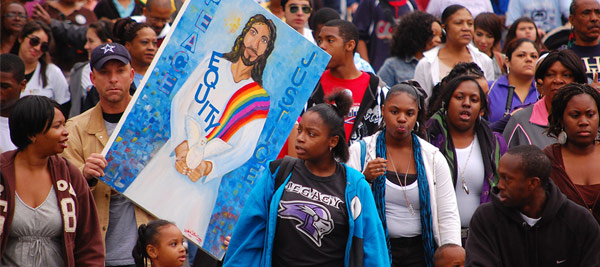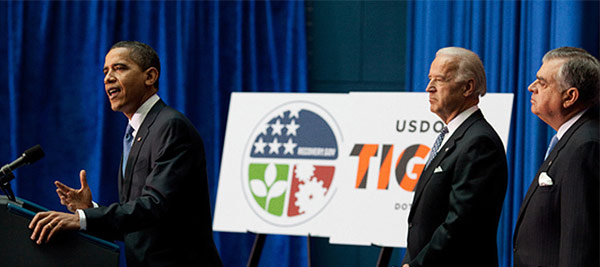Economic Recovery and Equal Opportunity in the Public Discourse
Introduction
As our nation struggles to recover from the worst economic downturn since the Great Depression, media coverage, public perception, and the relationship between them strongly influence public policy and its impact on Americans’ daily lives. The perceived effectiveness of the federal stimulus package—the American Recovery and Reinvestment Act, for example—can have a far greater impact on the subsequent policy debate than does the consensus of economists or the tracking of actual job creation. And the level and framing of reporting on issues of economic inequality, for instance, helps to determine the extent to which that issue becomes a political and policy priority, especially in an election year.
In order to understand those trends, and their implications for ongoing policy debates, The Opportunity Agenda undertook this study, Economic Recovery and Equal Opportunity in the Public Discourse. By analyzing the content of media reporting and recurrent themes across a large body of existing public opinion research, we seek to highlight the ways in which key news media are interpreting the current economic moment and the ways in which different segments of the American public understand it.
We chose to examine public discourse on both the economic recovery as a whole and its disparate barriers facing different groups of Americans because they are complementary dimensions of a single notion: the American Dream of greater and more equal opportunity for all. Because that national value is broadly shared and has been an explicit goal of many federal economic recovery efforts, we analyze the extent and ways in which it is reflected in the national conversation.
This report is intended to inform journalists about reporting trends and areas in which greater or more accurate reporting is needed. It strives to inform advocates of job creation and equal opportunity about challenges, openings, and strategies for mobilizing public will. And it aims to inform policymakers about public priorities as well as places where greater information, transparency, or political leadership are needed. Moreover, scholars, researchers, and activists are likely to take a keen interest in our findings and recommendations.
Methodology
Media Content Analysis
The news content analysis of the Economic Recovery and Equal Opportunity in the Media and the Public Mind report is based on an analysis of content in 17 mainstream newspapers, including the largest national newspapers in the country, and five regional ones; Newsweek magazine; and a limited number of transcripts of news and programs on the ABC, CBS, CNN, and NBC television networks. The timeframe of coverage was from October 2008 through May 2010.
Our analysis was conducted in two parts. We analyzed coverage of the economic recovery in general and coverage specific to recovery efforts in relation to inequality and economically vulnerable populations of Americans.
The first part was made up of a sample of 100 articles, of which 65 were appropriate for analysis, about the economic recovery generally and the American Recovery and Reinvestment Act. This sample is referred to in the report as the overall sample. To generate a pool of relevant articles, we searched for news on the Nexis database using words and phrases such as “economic stimulus,” “stimulus bill,” “stimulus package,” “Recovery Act,” and the “American Recovery and Reinvestment Act.”
The second part of the study was based on a sample of 150 stories, of which 60 were appropriate for analysis, about the impact of recovery policies on economic groups. This sample is referred to as the equity sample. To identify these stories, we performed a separate search on the Nexis database using a broad set of search terms: “stimulus package,” “women,” “gender,” “low income,” “middle class,” “African American,” “Latino,” “Hispanic,” “American Indian,” “Native American,”“Asian American,” “discrimination,” “disparity,” “opportunity,” “(un)employment,” “poverty,” “jobs creation,” and similar phrases.
Finally, the samples were drawn applying a random sequence generator on the entirety of both groups of articles and transcripts generated on Nexis to ensure a representative sample.
A list of the press and network TV outlets included in the analysis follows.
|
National Newspapers |
Circulation |
|
Atlanta Journal and Constitution |
196,200 |
|
Boston Globe |
232,432 |
|
Chicago Sun-Times |
268,803 |
|
Las Vegas Review-Journal |
174,876 |
|
Los Angeles Times |
616,606 |
|
New York Times |
951,063 |
|
Newsweek |
1,972,219 |
|
Philadelphia Inquirer |
356,189 |
|
San Francisco Chronicle |
241,330 |
|
USA Today |
1,826,622 |
|
Wall Street Journal |
2,092,523 |
|
Washington Post |
578,482 |
|
Regional Newspapers |
Circulation |
|
Arkansas Democrat-Gazette |
185,222 |
|
Clarion Ledger (Jackson, MS) |
65,300 |
|
Columbus Dispatch (Columbus, OH) |
170,179 |
|
Denver Post (Denver, CO) |
333,675 |
|
Times-Picayune (New Orleans, LA) |
157,068 |
|
Network Television |
|
|
ABC News |
Good Morning America, This Week |
|
CBS News |
60 Minutes, The Early Show |
|
CNN |
American Morning, CNN Newsroom, The Situation Room, Anderson Cooper 360 |
|
NBC News |
Today Show, Meet the Press |
|
Fox News |
Fox 9 News, Fox News Sunday, America’s Newsroom, Your World with Neil Cavuto, Special Report with Bret Baier, Fox Special Report with Brit Hume, O’Reilly Factor, Hannity, On the Record with Greta Van Susteren, Red Eye w/ Greg Gutfeld |
Public opinion research
This public opinion section is based on a synthesis and meta-analysis of attitudinal tracking surveys and recent public opinion studies by nationally known and reputable research organizations, media outlets, and issue groups. Most of the data examined are publicly available; some come from proprietary research, which was made available to The Opportunity Agenda for the purposes of this report.
We reviewed original data from more than 50 public opinion studies, the vast majority of which were surveys, which address topics relevant to the economy, the economic recovery, government, and equity issues. At least 30 of these studies informed the final analysis and our understanding of Americans’ views on relevant issues, as well as those segments of the public who would be most receptive to communications about an equitable recovery and opportunity for all in America. We looked at attitudinal surveys that have tracked opinion changes and trends in the United States over two years and, in a few cases, over the past few decades. The greatest majority of information, however, was provided by surveys conducted within the past two years, up to June 2010.
The studies referenced in this report meet The Opportunity Agenda’s standards and best practices for quality and objective public opinion research, including appropriate sample size, a methodologically sound design and research instrument, and inclusion of a balanced questionnaire for surveys and discussion guides for focus groups. The studies are listed at the back of this report under the heading “Public Opinion Research Sources.”
Finally, because opinion research has largely adopted racial categories utilized by the federal government, this section uses these categories as appropriate. The categories are defined as follows:
- White: any person who self-identifies as white only and non-Hispanic
- Black: any person who self-identifies as black only
- Asian: any person who self-identifies as Asian only
- American Indian and Alaska Native (AIAN): any person who self-identifies as AIAN only
- Hispanic: any person of any race who self-identifies as Hispanic
Acknowledgments
This report was authored by Eleni Delimpaltadaki, Public Opinion and Media Research Coordinator, and edited by Juhu Thukral, Director of Law and Advocacy, at The Opportunity Agenda. Special thanks to those who contributed to the analysis, editing, and design of the report, including Alan Jenkins, Julie Rowe, Janet Dewart Bell, and Christopher Moore, with Paulette J. Robinson. Additional thanks go to Andrea Goezinne and Jill Mizell for contributing to the collection and analysis of data.
This report was made possible by project support from the Open Society Foundations, the Public Welfare Foundation, The Atlantic Philanthropies, and the W. K. Kellogg Foundation. General operating support was provided by the Ford Foundation and the Starry Night Fund at Tides Foundation. The statements made and views expressed are those of The Opportunity Agenda.




